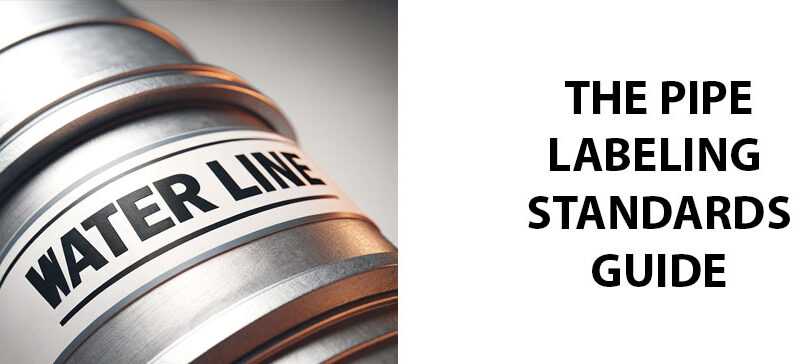Pipe labeling standards play a key role in keeping workers safe in your facility. By clearly labeling pipes according to ANSI standards, your organization can mitigate the risk of leaks, protect the environment, and keep your facility running smoothly.
If you’ve looking to learn more about ANSI pipe labeling standards, this guide is for you. We’ll discuss ANSI pipe labeling, color coding, label sizing, and more to help you understand how pipe labels work!
ANSI Pipe Labeling
The American National Standards Institute, or ANSI, coordinates and publishes safety standards for a variety of industries. ANSI/ASME A13.1 pipe labeling standards provides a standardized framework for labeling the pipes.
Pipe labels reduce the risk of accidents by clearly identifying what’s inside which pipe and what direction the pipe flows. In emergencies, leaks, or fires, this identification helps first responders respond appropriately. Pipe labeling also streamlines maintenance and repairs. In complex pipe systems, pipe labels are especially important for navigating the pipes without confusion.
Per ANSI pipe labeling standards, pipe labels must clearly identify the pipe contents, usually in uppercase letters. Arrows should be placed on the labels to show which way the pipe flows. These labels must be easily visible and placed in regular intervals. Following these standards leads to greater safety and efficiency in your facility.
ANSI Pipe Marking Color Code
The ANSI/ASME A13.1 pipe labeling standards use a color code to clearly identify pipe contents. Using color-coded labels provides a quick way to understand the nature of the pipe contents and any associated hazards. There are six predefined colors and four colors that can be defined by your organization:
- White text on red background: Fire quenching fluids
- Black text on orange background: Toxic or corrosive
- Black text on yellow background: Flammable and oxidizing fluids
- White text on Brown background: Combustible
- White text on green background: Other water
- White text on blue background: Compressed air
- White text on black background: Defined by user
- White text on gray background: Defined by user
- Black text on white background: Defined by user
- White text on purple background: Defined by user
If a pipe’s contents fit into multiple categories, it’s important to color code according to the most hazardous substance. Some organizations use the user defined color codes for this purpose. However you decide to label your pipes, you’ll need to train your employees and provide a key for reference.
Standard Piping Color Codes
While the ANSI/ASME A13.1 pipe labeling standard works for a lot of different industries, it isn’t the only color code for pipe labeling. Depending on the industry you’re in, you may need to follow a different color code.
For example, a lot of water and wastewater treatment facilities rely on the 10 States Standards to label and color code their pipes. Ammonia refrigeration systems, which have complex systems of pipes, use a modified version of ANSI/ASME A13.1 referred to in IIAR Bulletin No. 114. Medical facilities rely on NFPA 99 pipe labeling standards to color code their various compressed air and gas pipes.
And finally, ships at sea use ISO 14726 to label papers. This pipe labeling standard is especially useful when dealing with language barriers. The color code relies on bands of color to communicate the contents of pipes and can be understood internationally. Whatever industry you’re in, you’ll want to figure out which standard piping color code will work best for your facility.
Pipe Label Sizing
Label sizing is another important part of the pipe labeling standards. Choosing the right label size ensures that the label is readable. Per the pipe labeling standards, the size of the pipe label and text should be proportional to the diameter of the pipe.
Some examples of recommended label sizes include:
- Pipes 0.75 to 1.25 inches: 8 inch long labels with 0.5 inch letter height
- Pipes 1.5 inches to 2 inches: 8 inch long labels with 0.75 inch letter height
- Pipes 2.5 inches to 6 inches: 12 inch long labels with 1.25 inch letter height
- Pipes 8 to 10 inches: 24 inch long labels with 2.5 inch letter height
- Pipes larger than 10 inches: 32 inch long labels with 3.5 inch letter height
ASME A13.1
ASME A13.1 is a pipe labeling standard developed by the American Society of Mechanical Engineers (ASME). This code establishes a common system to identify the contents of pipes and the direction of flow. Previously, ANSI and ASME had separate labeling guidelines, but in 2007, the two organizations combined their recommendations for pipe labeling. Today, the standard is typically called ANSI/ASME A13.1. The standard provides clear guidelines for marking pipes to improve safety and operational efficiency.
Some key elements of ANSI/ASME A13.1 pipe labeling standards include:
- Label placement: Pipe labels should be placed at regular intervals, including on both sides of any valve or equipment, where pipes pass through walls or floors, at any change in direction, and at any branch points or junctions.
- Flow direction arrows: Arrows must be included on the pipe labels to show the direction of flow.
- Legibility: The text and color coding must stay legible over time. Illegible labels should be replaced.
- Durability: Labels should be made from materials that can withstand the environmental conditions where the pipes are located, such as extreme temperatures, chemical exposure, and physical wear and tear.
ASME A13.1 is important because it helps prevent accidents by clearly identifying hazardous substances. It also simplifies maintenance by providing consistent identification and helps facilities meet regulatory requirements.
If you’re looking to implement these pipe labeling standards in your facility, it’s important to take the time to do it right. Before you begin, conduct an assessment of the facility to determine which pipes need to be labeled. Make sure that all labels adhere to the ASME A13.1 pipe labeling standards, and train your employees so they understand how to interpret the labels. It’s also important to regularly inspect labels to make sure they’re legible and in good condition. Replace labels that have become worn or damaged as soon as possible.
The Prop 65 Labeling Requirements
OSHA Pipe Labeling Requirements
OSHA (Occupational Safety and Health Administration) does not have its own specific pipe labeling standards, but it does emphasize the importance of hazard communication in the workplace. Certain industries, like pulp, paper, and paperboard mills, textile facilities, and oxygen-fuel gas welding and cutting facilities, are required by OSHA regulation to follow ANSI/ASME A13.1 for marking pipes.
For other industries, there’s more leeway to choose which pipe labeling standards to follow. ANSI/ASME A13.1 is popular for its simplicity and versatility, but it doesn’t work for everyone. For example, water and wastewater treatment plants have miles of piping that carry water. The ANSI/ASME A13.1 color coding isn’t specific enough to delineate between clean water and raw sewage. Other color coding standards are used instead to more clearly identify the contents of these pipes.
To comply with OSHA’s pipe labeling requirements, you must research which regulations apply to your industry. Some industries rely on national or international standards, while others adopt local standards. Once you’ve identified the appropriate standards to follow, you’ll want to identify all pipes that contain hazardous substances in your facility.
Use durable labels that can withstand the environmental conditions. For example, at Coast Label, we can manufacture pipe labels made from chemical-resistant materials. Train your employees on the meaning of the labels and the hazards associated. You’ll also want to maintain records of the labeling system and update it when necessary. Following these steps will keep you compliant with OSHA and keep your employees safer.
If you’re looking for durable pipe labels, Coast Label has you covered. Our custom pipe labels can be engineered to withstand extreme temperatures, outdoor conditions, and chemical exposure. Contact Coast Label today for a proposal.


